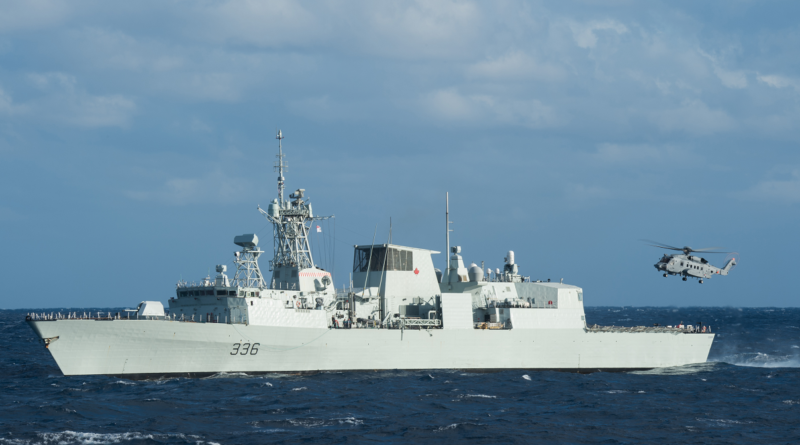Warship Orthography
- The full name of a warship1 in naval service includes the national identifier and a name (e.g., Her Majesty’s Canadian Ship Halifax; le navire canadien de sa majesté Ville De Québec).
- Prior to being put into commission, a ship is not a warship and her correct name does not include the national identifier. A warship may be de jure in commission when she is delivered by the shipbuilder to the Canadian Armed Forces prior to a formal commissioning ceremony. From delivery on her correct name includes the national identifier.
- A warship’s name other than the national identifier is italicized (e.g., HMCS Harry DeWolf). Military writers may per an operational writing convention capitalize the name.
- A national identifier may be written or spoken as an initialism2 (e.g., HMCS Kingston, HMC Ships Calgary and Vancouver; NCSM Montréal). The initialism may be used after being introduced the first time the full name is used [e.g., Her Majesty’s Canadian Ship (HMCS) Victoria].
- A warship’s name without the national identifier (e.g., Fredericton) may be used after the full name is first introduced in a written piece.
- The definite article ‘the’ is not used with a warship’s full name when the national identifier starts with a pronoun. ‘The HMCS St John’s’ is incorrect as it means ‘the Her…’ For other navies, usually non-monarchies, the definite article is acceptable though not necessary (e.g., the USS Virginia).
- After being paid off3, a warship is no longer a warship and her full name does not include the national identifier. The remaining part of her name may continue to be used, including with an article (e.g., the Cormorant). The national identifier can be used if made evident it is no longer current (e.g., the ex-HMCS Cormorant, the former HMCS Annapolis), but that form is best reserved for when referring to the ship’s past.
- Warships are designated by type (of a similar role and functions, e.g., frigate, destroyer). A paid off ex-warship is no longer the type of ship she was in service. If inoperable, she can be typed as a hulk.
- The warship type can be used to precede a name and there can be or not an article (e.g., the destroyer HMCS Iroquois). An archaic form of writing can place the type afterwards (e.g., HMCS Niobe, cruiser).
- Within a type, one or more warships of the same design are known as a class and take the name of the first or lead ship (e.g., Halifax-class frigates). When writing of a ship class, the national identifier and italics are not used and an article may be used (e.g., the Harry DeWolf-class).
- These conventions may apply to naval auxiliaries and to merchant ships. A merchant ship’s name is italicized but not her vessel type identifier, e.g., motor vessel Nunavik, MV Nunavik.
Notes:
1. Warship definition: “warship means a ship belonging to the armed forces of a State bearing the external marks distinguishing the character and nationality of such a ship, under the command of an officer duly commissioned by the government of that State and whose name appears in the appropriate service list or its equivalent, and manned by a crew which is under regular armed forces discipline;” San Remo Manual on International Law Applicable to Armed Conflicts at Sea Sec V para 13(g) (https://www.icrc.org/eng/resources/documents/misc/57jmsu.htm) accessed 9 April 2015
2. Prior to standardization on the initialism HMCS, identifiers included HMC S/M, where S/M means submarine, and HMC destroyer, both of which may occasionally be seen.
3. Warships of the Royal Canadian Navy (RCN) pay off (essentially, are taken out of naval service) at the end of a commission, which usually lasts the entire duration of the ship’s life in naval service. Other navies such as the United States Navy (USN) may use the term ‘decommission’ to mean similar to paying off, but it is incorrect to apply the term decommission to a RCN warship.
A PDF of this Information Note is available here.

